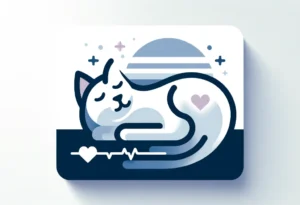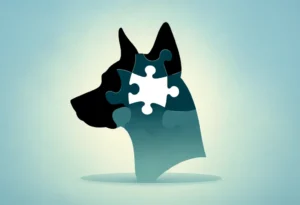Watching your feline friend age is like observing your favorite book weather: you cherish the story more while noticing the pages turning fragile. Witnessing signs of cognitive decline in your cat can feel akin to watching a piece of your heart quietly fade, but it doesn’t have to be a powerless experience.
This post will arm you with practical, compassionate strategies to support your aging companion, ensuring their golden years are filled with as much joy and comfort as possible.
Key takeaways:
- Spot early signs of cognitive decline, such as changes in sleep patterns or sudden disorientation, to act promptly.
- Enrich your cat’s diet with antioxidants and omega-3 fatty acids and introduce brain-stimulating activities to maintain cognitive health.
- Consult your vet for tailored advice and make your home more navigable to ease your cat’s comfort during their golden years.
What Are the Signs of Cognitive Decline in Cats?
Cognitive decline in cats, often referred to as feline cognitive dysfunction (FCD), can sneak up on pet owners. One day, your feline friend might seem just a bit off, and before you know it, you’re noticing a pattern of behaviors that point to something more significant. Here’s what to keep an eye out for:
-
Disorientation : Have you noticed your cat wandering into a room and seeming unsure of why it’s there? Or perhaps they stare into space a bit more than usual. These might be signs your cat is disoriented, a common symptom of cognitive decline.
-
Changes in Sleep Patterns : If your once nocturnal navigator is suddenly sleeping all day and pacing all night, take note. Shifts in sleep cycles are common in cats experiencing cognitive changes.
-
Unusual Vocalization : Excessive meowing or vocalization, especially at night, can indicate your cat is confused or anxious.
-
Decreased Hygiene : A cat that’s always prided itself on cleanliness might start neglecting grooming. This shift could be a tell-tale sign of cognitive issues.
-
Alterations in Social Behavior : Whether it’s an increase in clinginess or a newfound preference for solitude, any major change in how your cat interacts with you or other pets might be noteworthy.
Observing one or more of these behaviors warrants a conversation with your vet. Early detection is key to managing cognitive decline effectively.
How Can Diet Influence Cognitive Health?
When it comes to cognitive decline in cats, you are what you eat couldn’t be more accurate. A diet rich in antioxidants, omega-3 fatty acids, and other brain-boosting nutrients can make a world of difference. Here’s how to tweak your cat’s diet to support their cognitive health:
-
Antioxidants : Foods high in antioxidants can combat oxidative stress, a key factor in cognitive decline. Look for cat foods supplemented with Vitamin E and C, beta carotene, and selenium. An example includes Blue Buffalo’s Wilderness line, known for its antioxidant-rich LifeSource Bits.
-
Omega-3 Fatty Acids : These essential fats, particularly EPA and DHA found in fish oil, are proven to support brain health. Consider a fish oil supplement designed for pets, like Nordic Naturals Omega-3 Pet, ensuring you’re giving your cat a brain-boosting edge.
-
Specially Formulated Senior Diets : Many pet food brands now offer senior formulas specifically designed to support cognitive function with a blend of nutrients tailored for aging cats. Purina Pro Plan Bright Mind is a notable example, designed to promote alertness and mental sharpness.
Feeding your cat a balanced diet with these key components can help slow cognitive decline and keep their brain as sharp as their claws used to be.
What Environmental Adjustments Can Help?
As cats age and possibly confront cognitive decline, their environment can either become a source of comfort or stress. A few thoughtful adjustments can make a significant difference in their quality of life. Here’s how to tweak your home:
-
Create Easy Navigable Spaces : Senior cats with cognitive decline can become easily disoriented. Keep pathways clear and consistent, avoiding major rearrangements that might confuse your cat.
-
Safe Zones : Establish a few ‘safe zones’ in quiet corners of your home where your cat can retreat to if feeling overwhelmed. A comfortable bed, their favorite toys, and perhaps even an article of your clothing can make these spots comforting.
-
Extra Litter Boxes : Consider placing a few extra litter boxes in accessible locations. Older cats might find it challenging to reach the litter box in time, especially if they have to climb stairs.
-
Pheromone Diffusers : Products like Feliway mimic the natural, calming pheromones that cats produce, helping to ease anxiety and promote a sense of calm in your cat’s environment.
Here’s a unique tip not often mentioned: Interactive Toys That Stimulate Mental Engagement: Senior cats need mental stimulation to keep their cognitive functions sharp. Toys that require problem-solving, like puzzle feeders or those that mimic prey (think automated laser toys or wiggling wand toys), can provide both physical and mental exercise, potentially slowing down cognitive decline.
Incorporating these adjustments into your cat’s environment not only caters to their changing needs but also enhances the bond you share, offering comfort and reassurance during their golden years. Remember, small changes can make a big impact on your feline friend’s quality of life.
Are There Activities to Boost Cognitive Function?
Absolutely! Just like humans, cats can greatly benefit from exercises and activities that challenge their minds and keep them engaged. Introducing new toys, games, and habits can not only stimulate your cat’s brain but also strengthen the bond between you two. So, let’s get straight to the point and explore some effective ways to keep your cat’s mind sharp.
-
Interactive Toys : Toys that move unpredictably or require your cat to solve a puzzle to get a treat are fantastic for mental stimulation. An example is a laser pointer that encourages your cat to chase a moving target, or a puzzle feeder that makes them think about how to access their food.
-
New Experiences : Introducing new environments or changing the layout of your home can provide new and exciting challenges for your cat. This could be as simple as rearranging the furniture or as adventurous as safely taking them outside in a controlled setting, like a fenced yard or on a leash.
-
Training Sessions : Believe it or not, cats can learn tricks too! Using clicker training or offering treats as rewards, you can teach your cat to perform simple tasks. This not only boosts their cognitive function but also enhances their listening skills.
-
Social Interaction : Interaction with other cats or even people can provide social stimulation. Playdates with a friend’s cat (as long as both cats are comfortable with it) or setting aside time each day for one-on-one interaction can be very beneficial.
A unique tip: Set up an ‘obstacle course’ in your home using boxes, toys, and random household items. It encourages your cat to navigate through, over, and around objects, providing them with both physical exercise and mental stimulation. This fun activity is something most cat owners might not think of but can significantly impact maintaining cognitive health.
When Should You Consult a Veterinarian?
Pay close attention to your cat’s behavior and routine. Here are some red flags that signal it might be time to get a professional’s opinion:
-
Changes in Sleep Patterns : If your cat’s day-night cycle seems to be reversing or they’re sleeping much more than usual, it’s a sign something might be off.
-
Disorientation : Watch for signs of confusion or difficulty navigating around the house. If your cat seems lost in previously familiar territories, it’s a concern.
-
Altered Social Behavior : A cat that becomes overly clingy or, conversely, starts to withdraw and seek isolation more than usual might be experiencing cognitive issues.
-
House Soiling : Sudden lapses in litter box habits can indicate not just cognitive decline but potentially other health issues as well.
-
Changes in Activity Levels : Significant increase or decrease in activity can both be indicators of cognitive changes.
If you observe any of these signs or other unusual behaviors, it’s time to visit the vet. They’ll likely conduct a thorough examination to rule out any other potential health issues and might suggest a diagnosis of cognitive dysfunction. Treatment options can vary but may include medication to manage symptoms, dietary changes, or environmental adjustments to help your cat cope better.
What to Expect at the Vet Visit
Be prepared to discuss your cat’s behaviors, any changes you’ve observed, and your home environment. The veterinarian might suggest blood tests or other diagnostics to rule out underlying health issues that could mimic or contribute to cognitive decline. In terms of treatment, every cat is unique, and recommendations will be tailored to your cat’s needs. It could range from nutritional supplements, prescription diets specifically designed to support brain health, or environmental modifications to reduce stress and anxiety for your cat.
Remember, early detection and intervention are key. By keeping a close eye on your cat’s behavior and maintaining regular veterinary check-ups, you’re taking proactive steps towards ensuring their golden years are comfortable and joyous. Your cat has been your faithful companion – it’s our turn to be theirs as they age, offering them the care, love, and attention they deserve.
Alex, a passionate animal lover, has experience in training and understanding animal behavior. As a proud pet parent to two dogs and three cats, he founded AnimalReport.net to share insights from animal experts and expand his knowledge of the animal kingdom.










